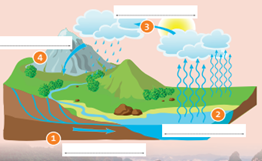Tiếng Anh 8 CLIL Geology: The water cycle1. Match the words in blue in the fact sheet with definitions 1–7. 2. Read the fact sheet. What happens to water when it falls to the Earth? 3. Label the diagram with the words in the box. 4. Read and listen to the fact sheet again. Answer the questions. Tổng hợp đề thi học kì 2 lớp 8 tất cả các môn - Chân trời sáng tạo Toán - Văn - Anh - Khoa học tự nhiên
Lựa chọn câu để xem lời giải nhanh hơn
Bài 1 I can understand the water cycle and describe the journey of a river (Tôi có thể hiểu vòng tuần hoàn của nước và mô tả hành trình của một dòng sông) 1. Match the words in blue in the fact sheet with definitions 1–7. (Nối các từ màu xanh lam trong tờ thông tin với các định nghĩa từ 1–7.) 1. changes from liquid into gas 2. changes from gas into liquid 3. rainfall 4. water when it exists in the air 5. the part of the land or body of water at the top 6. ice is in this state 7. water at room temperature is this Lời giải chi tiết:
1. changes from liquid into gas: evaporates (chuyển từ lỏng sang khí: bay hơi) 2. changes from gas into liquid: condenses (chuyển từ thể khí sang thể lỏng: ngưng tụ) 3. rainfall: precipitation (lượng mưa: lượng mưa) 4. water when it exists in the air: vapour (nước khi tồn tại trong không khí: hơi nước) 5. the part of the land or body of water at the top: surface (phần đất hoặc vùng nước ở trên cùng: bề mặt) 6. ice is in this state: solid (băng ở trạng thái này: rắn) 7. water at room temperature is this: liquid (nước ở nhiệt độ phòng là thế này: chất lỏng) Bài 2 2. Read the fact sheet. What happens to water when it falls to the Earth? (Đọc tờ thông tin. Điều gì xảy ra với nước khi nó rơi xuống Trái đất?) THE WATER CYCLE Now here is a challenge for you. Go and get a glass of water and take a look at it. Can you guess how old it is? Well, your water perhaps fell from a cloud just a couple of weeks ago, but it has been around for the same length of time as planet Earth! That means that your glass of water was around when the first creatures swam in the sea and when the dinosaurs roamed the Earth. But how is this possible? The fact is that the quantity of water on the Earth remains the same over time and it constantly goes through the water cycle. In the cycle, there is continuous movement of water on, above and below the surface of the Earth. Firstly, the sun heats the water in the rivers, seas and oceans, and it evaporates into the air. Plants and trees lose water, too, and this also goes up into the air. The water vapour then cools and condenses into small drops which form clouds. You can see how condensation happens if you look again at your glass of water on a hot day. After a short time, water from the air condenses onto the cold glass. Back to the sky, though, and the next step is that the clouds gradually get heavier and heavier until they can’t hold the water any more, and it falls to Earth as rain, sleet or snow. Water can change state from liquid to vapour to solid during the cycle, but any form of water that falls from the clouds is called precipitation. When on Earth, some of the water runs into rivers, lakes and streams and becomes surface water. Some enters the ground and forms underground rivers or lakes before eventually flowing back to the seas and oceans. The cycle is complete. (CHU KỲ NƯỚC Bây giờ đây là một thử thách cho bạn. Đi lấy một cốc nước và nhìn vào nó. Bạn có đoán được nó bao nhiêu tuổi không? Chà, nước của bạn có lẽ đã rơi xuống từ một đám mây chỉ vài tuần trước, nhưng nó đã tồn tại cùng khoảng thời gian với hành tinh Trái đất! Điều đó có nghĩa là cốc nước của bạn đã ở xung quanh khi những sinh vật đầu tiên bơi ở biển và khi những con khủng long lang thang trên Trái đất. Nhưng làm thế nào là điều này có thể? Thực tế là lượng nước trên Trái đất không đổi theo thời gian và nó liên tục trải qua vòng tuần hoàn nước. Trong chu trình, có sự chuyển động không ngừng của nước, trên và dưới bề mặt Trái đất. Đầu tiên, mặt trời làm nóng nước ở sông, biển và đại dương, và nó bốc hơi vào không khí. Thực vật và cây cối cũng bị mất nước, và điều này cũng bay lên không trung. Hơi nước sau đó nguội đi và ngưng tụ thành những giọt nhỏ tạo thành mây. Bạn có thể thấy sự ngưng tụ xảy ra như thế nào nếu bạn nhìn lại cốc nước của mình vào một ngày nắng nóng. Sau một thời gian ngắn, nước từ không khí ngưng tụ trên kính lạnh. Tuy nhiên, nó quay lại bầu trời và bước tiếp theo là các đám mây ngày càng nặng dần cho đến khi chúng không thể giữ nước nữa và rơi xuống Trái đất dưới dạng mưa, mưa tuyết hoặc tuyết. Nước có thể thay đổi trạng thái từ lỏng sang hơi sang rắn trong suốt chu kỳ, nhưng bất kỳ dạng nước nào rơi xuống từ các đám mây đều được gọi là kết tủa. Khi ở trên Trái đất, một phần nước chảy vào sông, hồ, suối và trở thành nước mặt. Một số xâm nhập vào lòng đất và tạo thành sông hoặc hồ ngầm trước khi chảy trở lại biển và đại dương. Chu trình đã hoàn tất.) Lời giải chi tiết: When falling to the Earth, some of the water runs into rivers, lakes and streams and becomes surface water. Some enters the ground and forms underground rivers or lakes. (Khi rơi xuống Trái đất, một phần nước chảy vào sông, hồ, suối và trở thành nước trên bề mặt. Một số đi vào lòng đất và tạo thành sông hoặc hồ ngầm.)
Bài 3 3. Label the diagram with the words in the box. (Dán nhãn sơ đồ bằng các từ trong hộp.)
Lời giải chi tiết: 1. water returns to the sea (nước quay trở về biển) 2. evaporation (bốc hơi) 3. condensation (ngưng tụ) 4. precipitation (lượng mưa)
Bài 4 4. Read and listen to the fact sheet again. Answer the questions. (Đọc và nghe lại tờ thông tin. Trả lời các câu hỏi.) 1. What is true about the amount of water on Earth? (Điều gì đúng về lượng nước trên Trái đất?) 2. Why does water vapour condense? (Tại sao hơi nước ngưng tụ?) 3. What happens to a glass of water on a hot day? (Điều gì xảy ra với cốc nước trong ngày nắng nóng?) 4. Name two forms of precipitation. Do you know any more? (Kể tên hai dạng kết tủa. Bạn có biết nữa không?) 5. What are the three states that water can be in? (Nước có thể ở ba trạng thái nào?) Lời giải chi tiết: 1. The amount of water on Earth doesn’t change over time. (Lượng nước trên Trái đất không thay đổi theo thời gian.) 2. Water vapour condenses when it cools. (Hơi nước ngưng tụ khi nguội lạnh đi.) 3. After a short time, water from the air condenses onto the cold glass. (Sau một thời gian ngắn, nước từ không khí ngưng tụ lại trên mặt kính lạnh.) 4. Name two forms of precipitation: rain, snow. I know some other types of precipitates which are: hail, ice crystal and drizzle. (Kể tên hai dạng kết tủa: mưa, tuyết. Tôi biết một số loại kết tủa khác đó là: mưa đá, pha lê băng và mưa phùn.) 5. The three states that water can be in are: solid (ice), liquid (water), gas (steam / vapour). (Nước có thể ở ba trạng thái: rắn (nước đá), lỏng (nước), khí (hơi).) Bài 5 5. USE IT! Work in pairs. Create a poster to show what happens in the water cycle. Include information from this page. (Làm việc theo cặp. Tạo một áp phích để hiển thị những gì xảy ra trong vòng tuần hoàn nước. Bao gồm thông tin từ trang này.) Lời giải chi tiết:
|

























